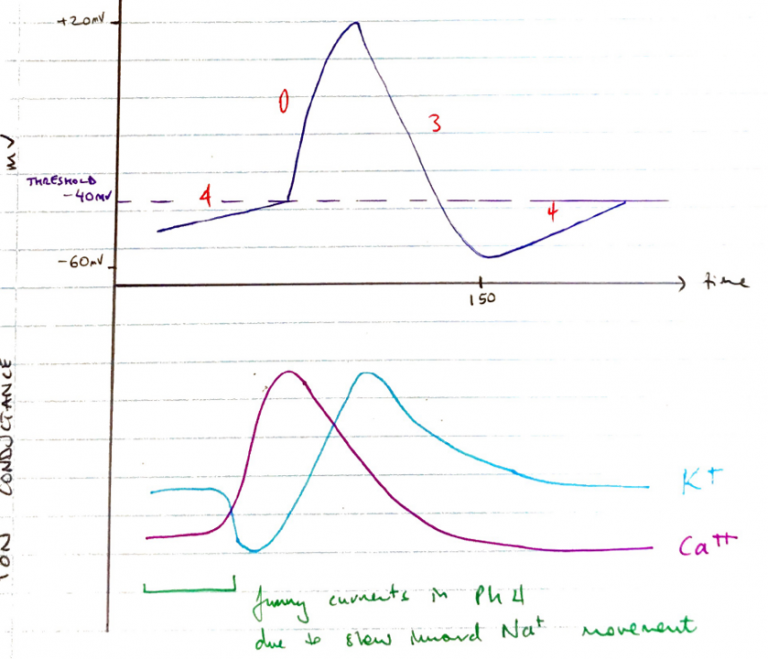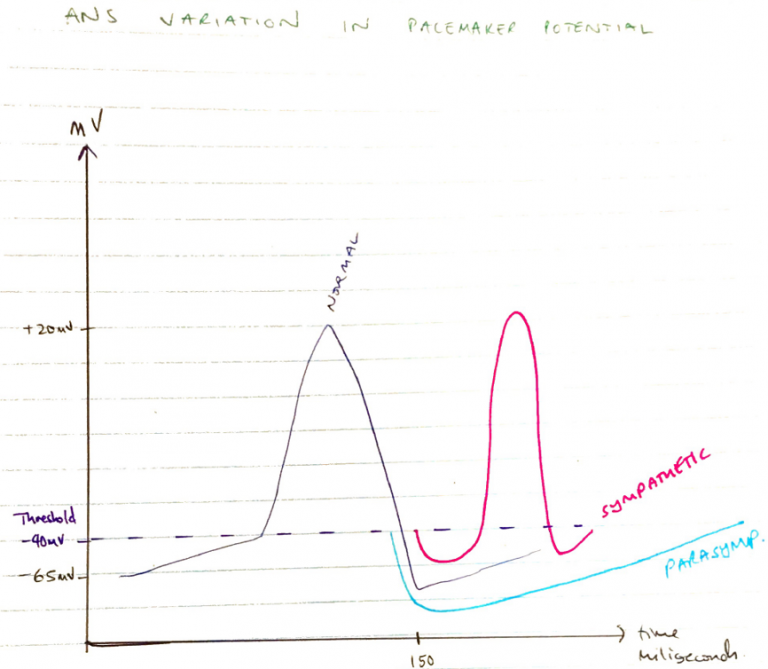- Site: SA Node, AV Node, ventricular conduction system
- Duration: 150 milliseconds
- RMP: -60mV
- Less negative because their membranes are naturally leaky to Na+/Ca2+
- At -55mV Fast Na+ channel n gates already closed ∴inactive
- ∴only slow type Ca2+ channel can cause an AP
- ∴rate of depol. is slow & Ph 0 upstroke is slow with less amplitude → hence name ‘Slow AP’
Features
• Ph 0: Depolarisation
- Membrane depolarised to -40mV
- Slow L-Type Ca2+ channel open
- Inward Ca2+ movement (slow ∴slow upstroke)
- Transient ↓K+ permeability further contributes to depolarisation
• Ph 3: Repolarisation
- Delayed rectifier K+ channel opens
- ↑K permeability repolarises cell
- Ca2+ channel closing & inactive
- Ph 3 ends when membrane potential reaches -65mV
• Ph 4: Spontaneous Slow Decay
- Mechanism unclear
- Multiple ionic currents involved
- ↓K+ permeability
- Slow inward Na+ movement KA ‘funny current’
- ↑Ca2+ permeability through T-type Ca2+ channel (T = transient)
- Then as begins to approach threshold, the L-type Ca2+ channel opens
NB: CCB do not block the T-type Ca2+ channels
Regulation of Slow AP
- Pacemaker potential seen in cells of cardiac excitatory system
- Denervated heart → SA Node fires at rate 100bpm
- At rest, vagal tone predominates → ∴AP generated ~70bpm
- This high intrinsic rhythmicity suppresses automaticity at other loci
- “Characteristics of PM potential are predominantly under control of ANS”
- ANS influences rate of PM firing
- Alters
- Slope of Ph 4
- Threshold trigger of Ph 0
- Degree of hyperpolarisation at end of Ph 3
Parasympathetic
- ↑K+ out & ↓Na+ & Ca2+ in
- Decrease slope Ph 4 ∴more time taken to reach threshold = ↓discharge rate
- More negative Ph 4 membrane potential
Notes on Spontaneous Decay
- Not really a ‘RMP’ in PM cell
- Constantly decaying ‘MP’
- Multiple ionic currents responsible influenced by cAMP
- ∴SYMP = ↑cAMP = ↑Ca2+ influx = steeper Ph 4 & rate of d/c
- Other factors all affect time to threshold (Rate of Decay)
- O2
- Thyroid hormones (↑Ca2+ & ↑[Adv rec])
- Temp
- K

